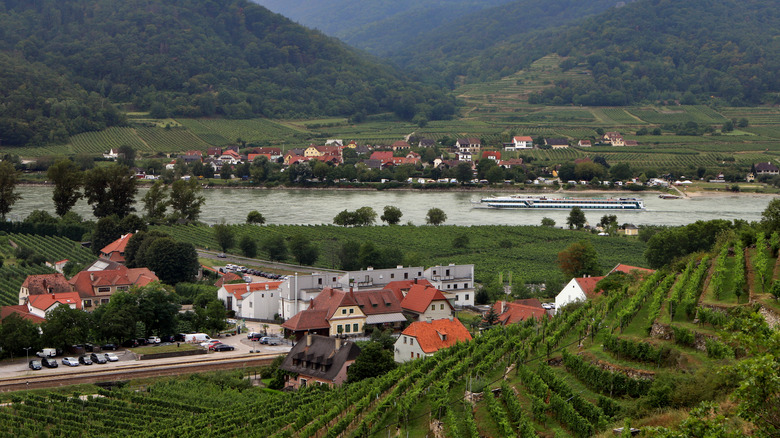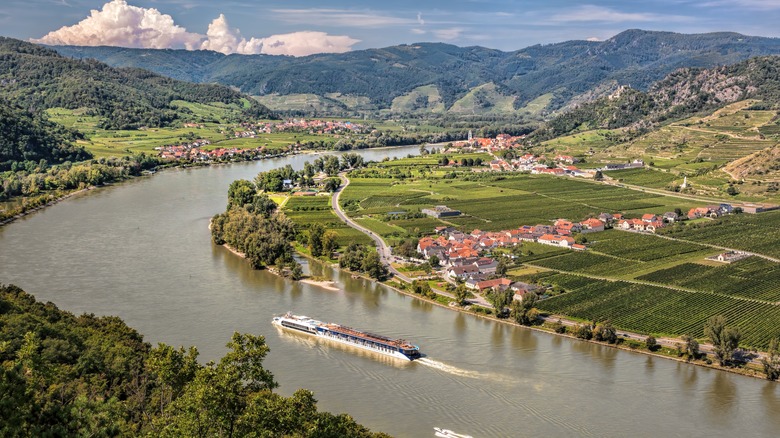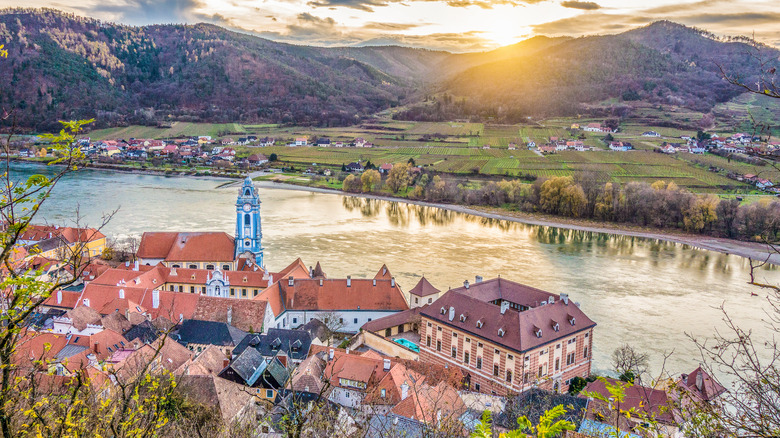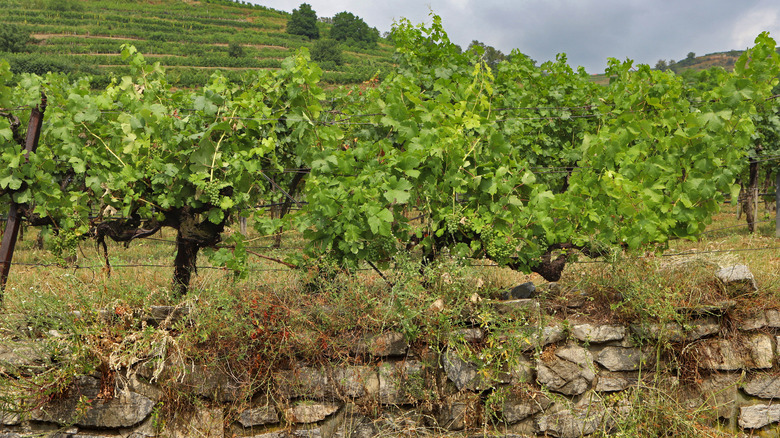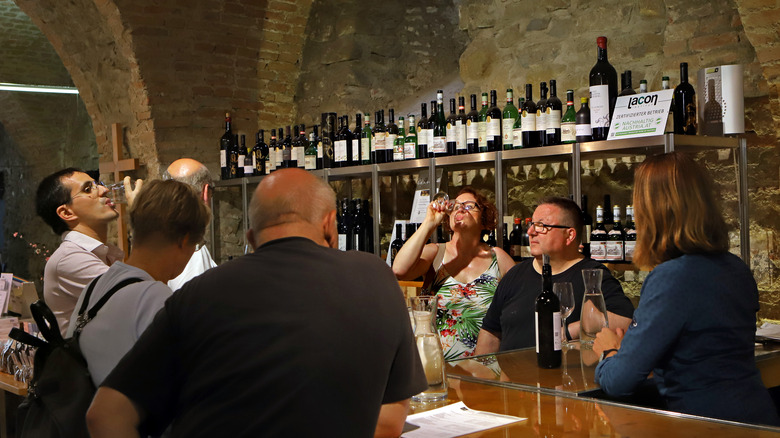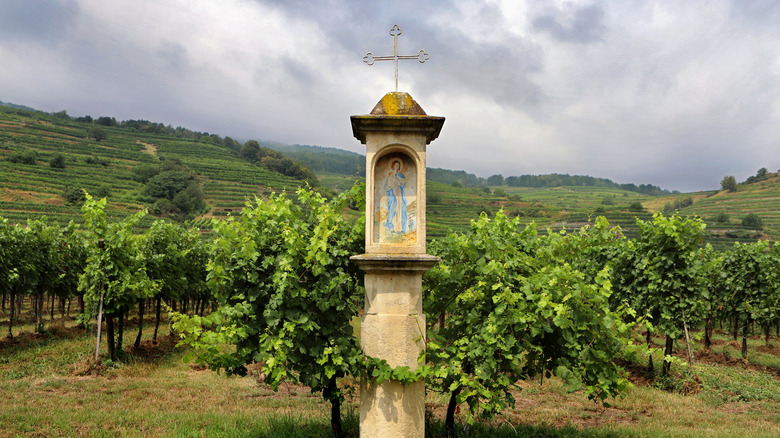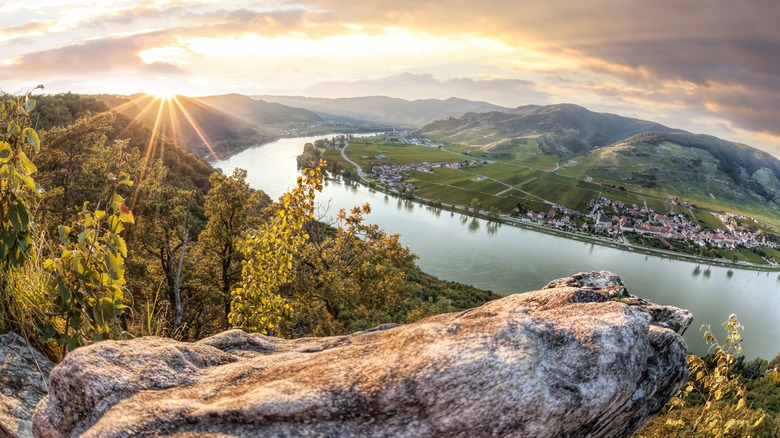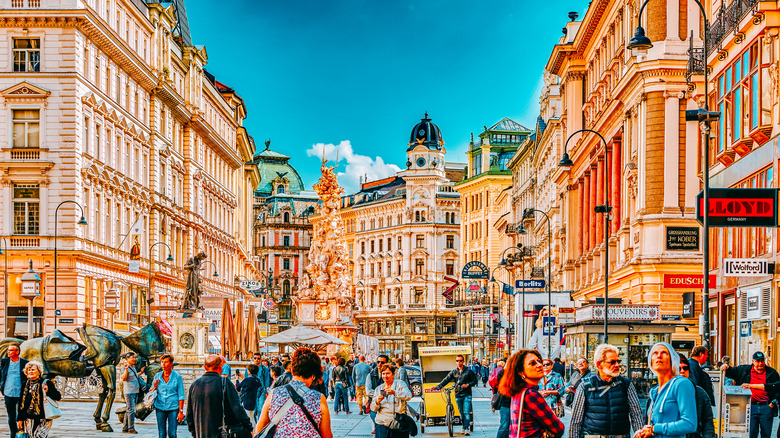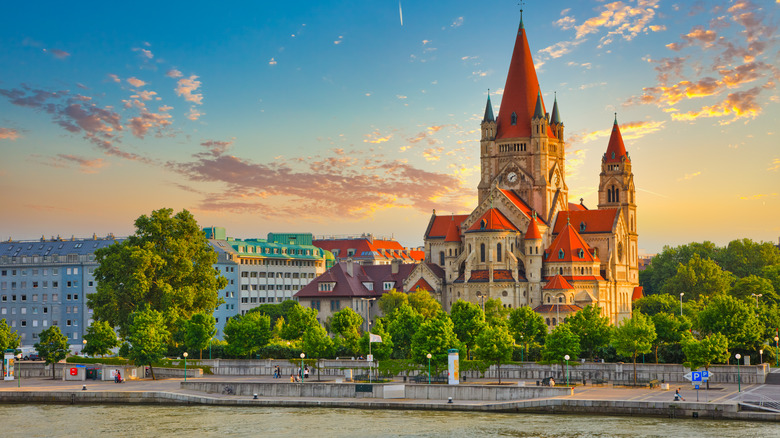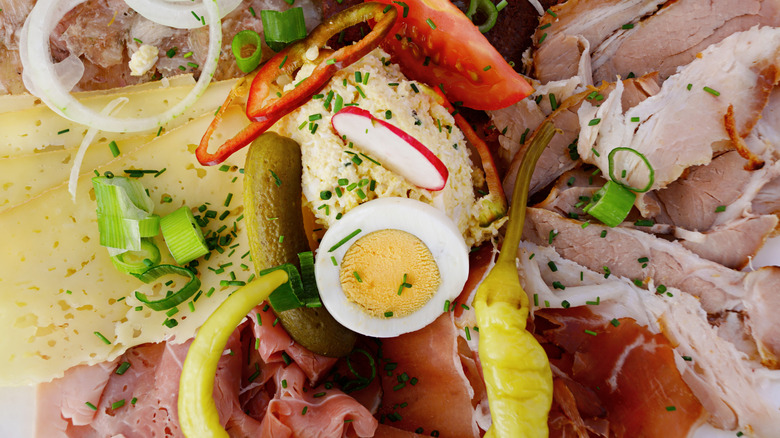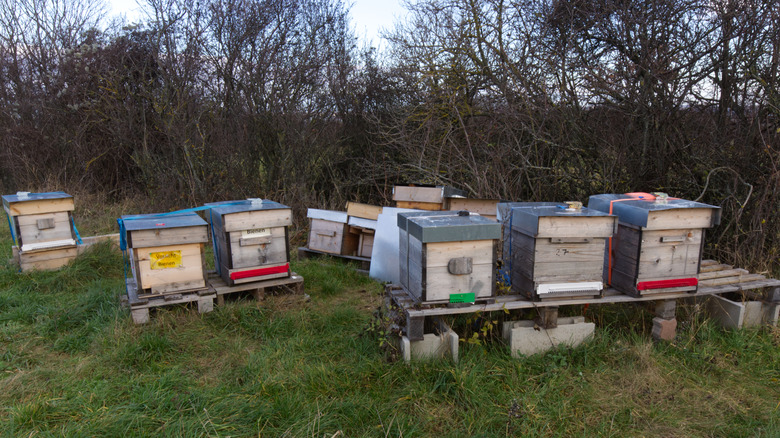The Beginner's Guide To Austrian Wines
Austria's winemaking history mirrors the larger wine landscape in Europe: ancient roots, ties with the Romans, church and religious influence, and impact from ruling classes. It's well worth a wine scholar's time to dive into the fascinating viticultural past of what's now the Republic of Austria, or Österreich in the local German language. But history is only a facet of one of the most dynamic Old World wine regions on the rise today.
Despite this rich wine growing and making heritage — and plenty of throwbacks that preserve the charm of the past — Austria's presence on the international stage is mainly due to the work of recent generations. A category dominated by small family producers, consumers are delighted to find wines with character that present unbeatable value. Attention to environmental responsibility and natural methods, wines with a tendency toward freshness, an interesting array of food-friendly varieties, and a second-to-none wine tourism opportunity make Austria one of the most exciting wine regions in the world right now.
Austrian wine is gaining new fans
According to reports from Austrian Wine, the year 2021 represented the country's greatest growth in value of all time. Revenue for the sector rose by nearly €30 million to €216.8 million (+15.7%), and exports increased by almost 4%. "A growing number of wine lovers around the world are realizing that there's hardly any other country that offers such consistent quality across the full spectrum of wine styles," wrote Chris Yorke, chief operating officer of Austrian Wine.
Austria is landlocked in Central Europe, and its neighbors Germany and Switzerland rank in the top three export markets, rounded out by the United States. Sparkling wine (Sekt) and white Qualitätswein (quality wine) enjoy particularly revitalized export interest. Qualitätswein represents a regulated category, identified by a red and white banderole on the capsule. When consumers see this, they know that origin, yield, and other criteria have been met. So while people might not always know each region or grape by name (German is the official language of Austrian wine), wine buyers recognize a seal that stands for quality.
Look East for Austrian winegrowing regions
Austria's leading wine-growing regions are situated primarily in the eastern part of the country. These are Niederösterreich, Burgenland, Steiermark, and Wien. (Translated in English to Lower Austria, Burgenland, Styria, and Vienna — an urban landscape in the capital city.) Niederösterreich contains eight additional designations, Burgenland six, Steiermark three, and Wien also includes a historical wine designation called Wiener Gemischter Satz, a field blend of various grapes from local vineyards, a wine tied to Viennese culture. Wines grown in regions not defined above are classified as Bergland, not to be confused with Burgenland.
But even these delineated aspects are sliced and diced with significant soil variance and unique microclimates. Also within this landscape are many fine vineyards (Rieds, in German). For a fascinating exploration of all of this, check out the digital maps from Austrian Wine, which offer an interactive look at all winegrowing site origins in a uniform, public resource. Look for the acronym DAC (Districtus Austriae Controllatus), which indicates an original designation for that bottle of Austrian Qualitätswein — similar to a DOC in Italy or AOP in France.
40 classified grape varieties
Austria is home to 40 classified grape varieties — 26 are white, and 14 are red. Some of these have names familiar to lovers of international styles, such as Chardonnay and Pinot Noir. Others are autochthonous, which refers to a grape that has been bred or mutated in such a way that it's considered natural in the setting and history of a region. Grüner Veltliner is Austria's signature white wine grape, while Zweigelt leads the way for red wine grapes. Other mainstays include Riesling, Welschriesling, Müller-Thurgau, and Sauvignon Blanc for whites and Blaufränkisch, Sankt Laurent, and Merlot for reds. White wine plantings represent about two-thirds of Austrian vineyards, leaving about a third for red wine cultivation, which has doubled over the past two decades.
Some winemakers in Austria are also at the forefront of resistant cultivars, varietal crossings known as PIWI. These grapes thrive despite fungal disease, making them less reliant on sanitary measures and chemical treatment of vineyard threats such as mildew. Many consider these grapes necessary in the wine industry's adaptation to ecologically responsible farming.
A range of interesting wine styles
Fans of Austrian wines appreciate a range of varieties and regions, from bubbly Sekt, refreshing whites, opulent reds, and sweet dessert wines to tantalize the palate. Rosé and orange wines also have a place in the spectrum. These are wines that pair with traditional Austrian cuisine, global flavors, and fine dining. Sommeliers recognize the versatility of these wines and are including them on wine lists in places like New York and Paris.
There is also a growing number of Austrian winemakers working naturally. While not defined by Austrian authority, there is an understanding of what this means: farming and cellar work without the use of chemicals, spontaneous fermentation, no additions or manipulations of the wine, no filtering, no fining, no sulfur additions, no temperature control during fermentation, and no use of new oak. Some of the most exciting winemaking under these conditions is happening in Austria.
Eyes on the environmental future
In the years after the second World War, the people of Austria realized the same demand for food products as most of the world. A rise in mechanization and chemical-driven farming extended to the vineyard, and many producers thought this new technology was part of the future. Gradually, it has been revealed that environmental and health concerns are not compatible with systems that rely on synthetics such as pesticides and herbicides.
Austrian wine producers now commit to positioning their wine as an ecologically and socially responsible option. To provide proof to the consumer, the Austrian Viticultural Association created an online evaluation, to which producers submit voluntarily and independently, facilitating the 'Sustainable Austria' designation. This is demonstrated with a logo that indicates that steps were taken to be sustainable to the environment, economy, and society. The certification touches on vineyard systems, fair wages, improved work settings, practical business management, and a preference for regional suppliers when possible. There are also a growing number of organic and biodynamic winemakers in Austria working with reputable certification bodies or simply adhering to these practices by principle.
The landscape of Austrian wine
Visitors who approach Austria through Vienna will find they are ideally situated to explore the iconic wine regions in and near the city and slightly further afield. Austria is known for the Alps, but as the mountains recede, the Pannonian Plain is revealed, and it's this area — on the borders with the Czech Republic, Slovakia, Hungary, and Slovenia — that supports most of Austria's viticulture.
Plantings are made on slopes and terraces, as well as rolling hills and flatlands on a diverse soil arrangement that provides immense variety to the wine industry and impacts the types of grapes that thrive in specific parts of Austria. The beautiful Danube River also influences nearby vineyards, bringing cool air from the north and furnishing a significant diurnal swing in the day and night temperatures for a long growing season. Austria also contains four climate zones, which lend unique terroir circumstances throughout the country.
A balance of innovation and tradition
Roman sites, monasteries, and medieval influence are all strong but distant parts of the viticultural history of what is now known as Austria. It's a small nation with over 9 million residents with a heritage that spans many directions, but since the 1990s, it has been a strong member of the European Union and one that is consistently earning positive attention on the world's wine stage.
While many generations have contributed to the face of Austrian wine, today's producers — some of which adhere to a family heritage, others are new to the and burgeoning scene — are embracing both international demand and newly formed priorities. Across the country, viticulture draws visitors, from Vienna's busting wine taverns to country wineries with vineyard tastings to restored castles and ancient sites that now welcome hospitality establishments. Austrian wine's culture is vibrant, with a balance of tradition and innovation.
Wine in and out of Vienna
One of the most unique aspects of Austria is that Vienna — or Wien (pronounced Veen) — the capital city with the most urban vineyards and wineries in all of the world. There are approximately 400 vineyards within the city alone, and many of these were previously part of smaller villages that the capital has since incorporated. There are charming wine taverns called Heurigen, where people can enjoy local food and drink in a casual atmosphere. This makes dipping into the wine scene highly accessible for travelers.
The county has six international airports, but most people will arrive through Vienna International Airport. Visitors can also bike through the wine regions or enjoy Danube River cruises, some of which offer world-class luxury and service. The country is also quite drivable, which allows travelers to self-guide a trip through one or more wine regions on Austria's well-developed roadway system.
Austrian wine and the world's cuisine
Austrian wine was made for local dishes such as Wiener Schnitzel and Sachertorte — and it's no doubt that these will make interesting pairings. But the sheer variety of Austrian wines offers incredible versatility in global cuisines. It's also been a matter of necessity for the Austrian wine industry to convenience sommeliers and restaurateurs that these wines will pair with more traditional foods like filet mignon or pasta because there are relatively few Austrian dining establishments in the world's major cities — where one can always find a steakhouse or Italian restaurant. Many places will offer bottles from Austria if the wine list is thoughtful and diverse.
Because there are so wide varieties and wine styles, it's not difficult to pinpoint Austrian wines that will go with familiar favorites such as pizza night, sushi, tacos, or vegetarian dishes. The German names of Austrian wines shouldn't put diners off — they are much more international in profile and scope.
The future of Austrian wine
Austrian wine is developing a reputation for biodiversity, natural winemaking, and forward-thinking about climate change. For example, the Wachau winegrowers' association recently produced a biodiversity report with plans to expand bird nesting habitat and soil ecology. In Steiermark, a group of winemakers called Steirische Terroir & Klassik Weingüter (STK) has developed a seal for participating producers that adhere to region-specific winemaking and uphold the local terroir.
The country has also established Sustainable Austria, which allows producers to self-certify on a set of metrics that ensure longevity and ecological responsibility. This will permit wine bottles to bear a stamp that let's consumers know they are purchasing a product made with demonstrated efforts that benefit the environment and community. And globally, wine enthusiasts know that Austria is one of the most exciting regions for natural wines — Karakterre, a fair highlighting natural, organic, and biodynamic wines from central and eastern Europe, is held in Vienna each year.
